In the ever-evolving landscape of U.S. real estate, the implications of recent tariff announcements are sending shockwaves through the construction industry. As building contractors begin to raise their prices by as much as 30% in anticipation of looming tariffs, the dream of affordable housing is slipping further from reach. This alarming trend is more than just a fleeting response to political maneuvering; it is reshaping the financial viability of future developments. The crux of the issue lies in President Donald Trump’s imposition of tariffs—25% on steel and aluminum imported from Canada and Mexico—further complicating an already convoluted housing market.
The anticipated escalation in project costs is not simply a knee-jerk reaction to existing tariffs but rather a calculated defense against future price hikes. Closely observing the industry’s pulse, the CEO of a prominent development firm, Jon Paul Pérez of Related Group, has articulated the anxiety plaguing contractors who fortify their bids with cautionary marks. “There’s a cushion being added by subcontractors; they’re bracing for impact,” Pérez recently explained during an industry discussion. The reality is unsettling: this protective pricing strategy invariably thrusts the burden onto potential homeowners, exacerbating the crisis of affordability in a market where inflation and high-interest rates already reign supreme.
Inflation Meets Construction
The correlation between rising material costs and looming tariffs is stark. According to a survey conducted by the National Association of Home Builders, the increase in construction materials may inflate the cost of an average home by approximately $9,200. For many prospective buyers, particularly first-time homeowners, this financial burden is an insurmountable barrier. It’s a bitter pill to swallow, especially when compounded by a housing market that is already grappling with skyrocketing prices.
While some segments of the Miami real estate market continue to thrive—luxury penthouses and high-end properties still attract buyers willing to invest over $10 million—the middle market sits in limbo. Pérez has made it clear that while the wealthiest are relatively insulated from these price hikes, the middle-income buyers, looking to invest between $1 million and $3 million, are much less certain about their purchasing power in this fluctuating economic climate. They are understandably cautious, adopting a wait-and-see approach, as they grapple with the fear and uncertainty that seems to permeate the market.
Immigration Policies and Their Economic Impact
As if tariffs weren’t enough, the broader implications of U.S. immigration policies further complicate the issue. The construction industry, heavily reliant on a diverse labor pool, now faces additional hurdles as the Trump administration enacts stricter immigration regulations. Pérez warns that losing these essential workers will not only heighten construction costs but will result in broader inflationary pressures. The underlying truth is that the health of the real estate market is deeply intertwined with labor availability—a connection that is often overlooked amid discussions of materials and tariffs.
The community of potential buyers from Canada and Latin America holds its breath, grappling with the uncertainty surrounding immigration policies. A number of buyers, once poised to make significant investments, are now hesitant, choosing to walk away from deals rather than gamble on unclear futures. “We lost eight Canadian and Mexican buyers who were eager to purchase; fear about tariffs and immigration got in the way,” Pérez lamented. The apprehension among these buyers echoes throughout the market, revealing an unsettling vulnerability as foreign investors rethink their commitment to U.S. properties.
The Vision for the Future
Amidst this tumultuous landscape, one must wonder: what lies ahead for the American real estate market? Historically, cycles of stability and volatility have characterized this sector, but current trends appear particularly disconcerting. The reality is that the proliferation of tariffs and immigration crackdowns portend a different future—one where builders, buyers, and even renters face harsh and prolonged challenges. By understanding the intricate web of factors contributing to this evolving crisis, we can gain insight into the urgent need for a more cohesive, liberal, and pragmatic approach to housing policy that addresses these compounding pressures.
As the housing market braces for a potential price explosion, only time will tell if proactive measures and thoughtful dialogue can avert a looming economic catastrophe. It seems clear, however, that maintaining the vitality of America’s housing market is not merely an act of economic interest, but a crucial endeavor that will impact millions of lives—now and in the years to come. The stakes have never been higher.

